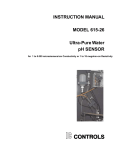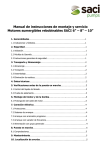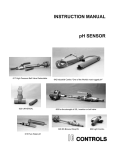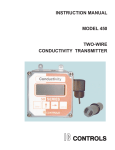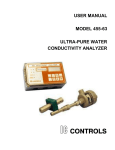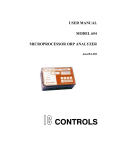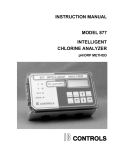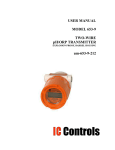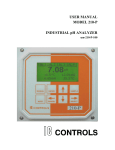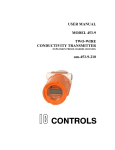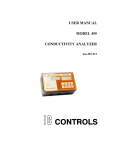Download 615-25 User Manual (Pure Water)
Transcript
INSTRUCTION MANUAL MODEL 615-25 pH SENSOR for Pure Water from 15 to 1 microsiemens IC CONTROLS Contents General Information . . . . . . . . . . . . . . . . . . . Introduction . . . . . . . . . . . . . . . . . . . . . . pH Reaction Chemistry . . . . . . . . . . . . . . . . pH Measuring Elements . . . . . . . . . . . . . . . . Reference Electrodes . . . . . . . . . . . . . . . . . pH in Low Conductivity Waters . . . . . . . . . . . . Pure Water pH Measurement . . . . . . . . . . . . . . Low Conductivity Samples . . . . . . . . . . . . . . Low Conductivity Symptoms . . . . . . . . . . . . . Carbon Dioxide . . . . . . . . . . . . . . . . . . . . Laboratory Solutions . . . . . . . . . . . . . . . . . . On-Line Solutions . . . . . . . . . . . . . . . . . . . Calibration Procedure . . . . . . . . . . . . . . . . . . Grab Sample Calibration . . . . . . . . . . . . . . . Procedure for Grab Sample Laboratory Calibration. . Two-Buffer Calibration Using Low Conductivity Buffers Maintenance . . . . . . . . . . . . . . . . . . . . . . . Daily . . . . . . . . . . . . . . . . . . . . . . . . . . Weekly . . . . . . . . . . . . . . . . . . . . . . . . . Quarterly . . . . . . . . . . . . . . . . . . . . . . . . Annual Routine . . . . . . . . . . . . . . . . . . . . Troubleshooting . . . . . . . . . . . . . . . . . . . . . Isolating the Problem . . . . . . . . . . . . . . . . . Analyzer Problem Troubleshooting . . . . . . . . . . pH Electrode (Sensor) Troubleshooting . . . . . . . . Checking The Automatic Temperature Compensator . Checking the Reference Electrode . . . . . . . . . . Checking the Glass Electrode . . . . . . . . . . . . . Electronics/wiring Problems . . . . . . . . . . . . . . APPENDIX A: Recommended Supplies . . . . . . . . APPENDIX B: Product Selection . . . . . . . . . . . Model 615 . . . . . . . . . . . . . . . . . . . . . . . Model 655 . . . . . . . . . . . . . . . . . . . . . . . APPENDIX C: Installation . . . . . . . . . . . . . . . . Checking the pH Measuring Electrode . . . . . . . . Checking the Reference . . . . . . . . . . . . . . . . Checking The Temperature Compensator And Preamp Typical Flow Mounting . . . . . . . . . . . . . . . . . Electrical Connections . . . . . . . . . . . . . . . . . APPENDIX D: Pumped Buffer Calibration . . . . . . . APPENDIX E: DRAWINGS . . . . . . . . . . . . . . . Mounting Dimensions . . . . . . . . . . . . . . . . . Wiring 615-25 . . . . . . . . . . . . . . . . . . . . . Industrial Products Warranty . . . . . . . . . . . . . . 615-25 Instructions INST615-25-111 . . . . . . . . . . . . . . . . . . . . . . . . . . . . . . . . . . . . . . . . . . . . . . . . . . . . . . . . . . . . . . . . . . . . . . . . . . . . . . . . . . . . . . . . . . . . . . . . . . . . . . . . . . . . . . . . . . . . . . . . . . . . . . . . . . . . . . . . . . . . . . . . . . . . . . . . . . . . . . . . . . . . . . . . . . . . . . . . . . . . . . . . . . . . . . . . . . . . . . . . . . . . . . . . . . . . . . . . . . . . . . . . . . . . . . . . . . . . . . . . . . . . . . . . . . . . . . . . . . . . . . . . . . . . . . . . . . . . . . . . . . . . . . . . . . . . . . . . . . . . . . . . . . . . . . . . . . . . . . . . . . . . . . . . . . . . . . . . . . . . . . . . . . . . . . . . . . . . . . . . . . . . . . . . . . . . . . . . . . . . . . . . . . . . . . . . . . . . . . . . . . . . . . . . . . . . . . . . . . . . . . . . . . . . . . . . . . . . . . . . . . . . . . . . . . . . . . . . . . . . . . . . . . . . . . . . . . . . . . . . . . . . . . . . . . . . . . . . . . . . . . . . . . . . . . . . . . . . . . . . . . . . . . . . . . . . . . . . . . . . . . . . . . . . . . . . . . . . . . . . . . . . . . . . . . . . 2 2 2 3 3 3 4 4 4 5 5 6 7 7 8 9 10 10 10 10 11 12 12 13 14 18 18 18 18 20 21 21 22 23 23 23 23 23 23 24 25 25 26 27 Page 1 IC CONTROLS General Information General Information Introduction The IC CONTROLS industrial pH sensor forms an electrode pair for the detection of hydrogen ion activity with provision for special requirements imposed by continuous operation in process environments. pH is a way of expressing the apparent availability of hydrogen ions in a solution in a form that will react, and is defined as “the negative logarithm of hydrogen-ion activity”. In most solutions the hydrogen ion concentration is going to be only a fraction. Water for example is composed of one hydrogen ion (H+) and one hydroxyl ion (OH-) that reacted together to produce one water molecule (H20). H+ + OH- = H20 Molecules made by such reactions show some tendency to break- up (or dissociate) into the original ions. For water, chemists found this break-up produces 0.0000001 mole of hydrogen ions per liter of water, (1 mole = 1 x molecular weight). For strong hydrochloric acid (say 1.0 molar) chemists found 1.0 mole of hydrogen ions per liter. For sodium hydroxide (1.0 molar) they found 0.00000000000001 mole of hydrogen ions per liter. They also found it difficult to handle these cumbersome numbers, and in 1909 Danish scientist Sven P.L. Sorensen suggested that the logarithm of the number be used. Since logarithms express a number as the power to, which 10 must be raised to equal that number; with a fraction the power will be negative. Eg. 10+ 2 = (10 x 10) = 100, while 10-2 = (1/10 x 1/10) = (1/100) = 0.01 Thus the above examples become: water 0.0000001 strong hydrochloric 1.0 sodium hydroxide .00000000000001 and you get a pH scale = 10-7 = 7 = 100 = 0 = 10-14 = 14 0 to 7 to 14 pH Reaction Chemistry Sometimes with pH reactions people encounter difficulties. One reason is the pH scale 0 to 14 which looks simple and linear, but as can be seen above is actually a logarithmic change of 1 to 10 between any two numbers. A second reason is the difference between mole and normal. 1 mole is defined as 1 x (the molecular weight of a substance in grams) [1 mole is actually 1 Avogadro number (6.023 x 1023) of atoms or molecules] and 1 molar is defined as 1 x (the molecular weight of solute in 1 liter of solution). For substances with complex formula’s the molecular weight is the formula weight of the combined molecules. Once formula’s get involved it is easy to see the inpact on pH (hydrogen ion) going from 1 molar HCl to 1 molar H2SO4, clearly the H+ ratio is not unity. To make it easier Normality is introduced and the equivalent weight of the substance is used instead of the formula weight. 1 normal is defined as 1 x (equivalent weight of solute in 1 liter of solution). In pH acid-base reactions, one equivalent is the number of grams of a substance that combines with, or supplies, one Avogadro number of hydrogen ions. So 1 eq. of HCl = 1 mole, or 36.5 g of HCl, and is 1 normal; wheras 1 eq of H2SO4 = 1/2 mole, or 49g of H2SO4 (not 98g), and is 1 normal. Therefore a 1 molar H2SO4 solution (98g/L) is 2 normal (1N H2SO4 is 49g/L) So eq wt = formula wt/number of H+ ions. The advantage is a given volume of a normal solution will react with an equal volume of another solution having the same normality. A third reason is that the pH of solutions exhibit buffer action or resistance to pH change at various pH values. These regions of resistance to pH change cause the observed pH to not change with ongoing reagent addition and then suddenly begin to change, even rapidly change, with the same ongoing reagent addition rate. The Page 2 615-25 Instructions General Information IC CONTROLS buffer effects exhibit different pH resistance points and different pH stiffness for each chemical involved, so a real world situation can be very complex and not appear to be repeatable; a real can of worms, so to speak. Since this adds on to the logarithmic base nature of pH, it can be a major challenge to control. Reaction Demand Curves done for all possible extreams of chemicals is one way to unravel this can of worms. pH Measuring Elements Physical and chemical properties of the process and the electrode pair are important as in a liquid ions can move anywhere without restriction. A pH measuring electrode measures hydrogen ions by establishing a physical-chemical balance, or equilibrium, between the available hydrogen ions in the process solution and attractive parking sites for hydrogen ions in the glass sensing membrane. Thus if there are other ions that move in and occupy the landing sites, or fast flow that upsets the chemical balance, or high/low temperatures that speed up or retard the equilibrium being established (similar to speeding up evaporation from a dish of water by heating or boiling it) clearly the user needs to make provision for the effects on the measurement. Reference Electrodes A pH reference electrode completes the electrical circuit to the outside of the pH measuring electrode by providing a means to release ions into the process, while at the same time duplicating the thermocouple type temperature dependant error voltage generated inside the pH measuring electrode when it’s fluid and solid conductors meet. Thus the reference both completes the electrical path and produces an identical (when referenced to the glass electrode error voltage) reference voltage which appears with opposite polarity to the pH meter and cancels all but the pH signal produced by hydrogen ion presence. Clearly process ions travelling backwards in the reference electrode ion release route can, if they react with the reference internal, change the reference voltage causing drift. High concentrations of process ions can change the nature of the reference fill so that an entirely unwanted voltage results. Reactions can precipitate certain components and/or block the ion routes producing an unwanted voltage drop in series with the pH signal, as can films or coatings of material from the process. IC CONTROLS have developed ways of dealing with these problems, and once identified our staff will be pleased to assist. Call us toll free at: 1(800)265-9161 if you have any questions. pH in Low Conductivity Waters High Purety Waters are generally those with a conductivity less than 15 micro Siemen but more than 1 micro Siemen. Ultra Pure Waters are generally those with a conductivity less than 1 microSiemen, or high resistivity of 1 meg ohm to 18 meg ohms at 25°C. Waters with such insulating properties are prone to act like an open circuit and cause the pH electrodes to become a good antenna, jumping at every little upset or passing person. Great care is needed in grounding to cut interference. Even friction from sample water flow can cause static buildup. Also the high purity means few ions to take part in the pH electrical circuit, with resultant flow sensitivity (ions swept away at different rates) and fast aging of the pH glass (ions swept to waste are seldom replaced). The 615-25 pH sensor has been designed to minimize these problems in High Purity Waters, however High Purity pH measurement still requires care on the users part. The 615-26 pH sensor has been designed to minimize these problems even with the more extreme conditions in Ultra Pure Waters, however Ultra Pure pH measurement still requires more care on the users part. 615-25 Instructions Page 3 IC CONTROLS Pure Water pH Measurement Pure Water pH Measurement Low Conductivity Samples Normally pH measurements are made in waters with 1,000 to 10,000 micro Siemen Conductivity. The conductivity comes from dissolved solids, typically salts plus net acid or base which explains the exhibited pH. These dissolved substances are in the solution in ion form, which makes such solutions good conductors. With 1,000 micro Siemen conductivity of mobile ions pH electrodes have a good circuit and give fast accurate pH readings. When Pure Waters are encountered standard pH electrodes begin to exhibit less reliable results. They seem to respond more slowly, appear to drift, and do not reproduce calibration results between Buffers and Grab Sample. On Highly Pure waters, pH electrodes become jumpy, flow sensitive and apparently inaccurate. Pure Water is a relative term for Low Conductivity Waters of less than about 500 micro Siemen. IC CONTROLS has observed some of these effects on waters between 50 and 500 micro Siemen, most likely due to pH Buffer carry over on the pH electrode. IC CONTROLS considers waters below 50 micro Siemen to be High Purity samples and recommends High Purity modification on all samples less than 15 micro Siemen. We consider waters below 5 micro Siemen to be Ultra Pure and recommend Ultra Pure modification on all applications below 1 micro Siemen. Typical Pure Water Streams are: Micro Siemen 1) purified effluent waters 50 to 250 2) surface waters in high rain areas 25 to 150 3) well waters in high rain, sand soil areas 50 to 100 4) process water in purification plants 5 to 150 5) process condensate waters 5 to 100 6) steam condensate 1 to 15 7) boiler feed water 1 to 15 8) reverse osmosis and distilled waters 0.5 to 10 9) deionized water 0.1 to 2 Low Conductivity Symptoms Low conductivity effects can be traced to; concentrated pH Buffer carryover into low conductivity sample, differences between reference junction potential in low sample conductivity vs in high buffer conductivity, differences in apparent reference junction potential as rate of flow through the pH flowcell washes ions away from the reference, absorption of carbon dioxide by low conductivity sample when exposed to air for calibration, and high resistance of the pure water producing a jumpy ungrounded “antenna” effect in the pH electrode pair. The effects will become more noticeable as the conductivity falls from simply Pure, to High Purity, and on to Ultra Pure, where below 1 micro Siemen they become predominant. Also the effects become more noticeable as greater accuracy is required. Buffer carryover Standardizing a pH electrode in a high conductivity buffer will increase the time required for the reading to stabilize in low conductivity sample. After regular pH buffer was pumped through a general purpose pH flow-cell in laboratory tests, IC CONTROLS observed 3 hours of pH electrode drift before a 1 micro Siemen sample stabilized. Alternatively Grab sample calibration with regular pH buffers risks pH Buffer carryover contamination of the sample. The best results will occur when pH Page 4 615-25 Instructions Pure Water pH Measurement IC CONTROLS Buffers and sample are close to the same conductivity. Reference Liquid Junction Potential A junction potential occurs when the reference electrolyte contacts the sample (much like the thermocouple potential that occurs when two different metallic conductors are in contact). The junction potential will vary in size with differences in composition between the electrolyte and sample. Unlike metallic conductors, liquids are mobile and diffuse into each other until diffusion pressure equalizes. Since in an electrolyte the charge carriers are ions which have different sizes and charges which affect their ability to move through the solution, concentrations of various sizes and charges may tend to separate out at the liquid junction producing a junction potential. While a junction potential can be standardized out, it must remain constant to fully disappear. With a big concentration differences between low conductivity sample and the reference electrolyte there will be a larger junction potential, and with any sample flow variation, drifty pH readings are seen, due to changes in the rate that ions are washed away . In the laboratory steady readings can be achieved by measuring in samples and standards with conductivity similar to the reference electrolyte. For on-line samples constant flow rates and attention to flow path are needed to achieve steady junction potentials and readings. Carbon Dioxide Since High Purity water contains little dissolved material, its resistance to pH change (buffer capacity) is small. Absorption of carbon dioxide on exposure to air will result in carbonic acid formation and cause a real change in pH. Most often this is seen as a change in pH (drift) from the original field reading and the same sample back in the laboratory. This fact can be readily demonstrated by taking a beaker of fresh demin water from a laboratory column, with pH electrode inserted and showing approximately 7 pH, then bubbling compressed air through it and observing the pH reading quickly fall to between 5 to 5.5 as it reaches saturation. For on-line samples in stainless line this is not a problem until someone draws a sample to take to the lab for comparison, and it absorbs carbon dioxide along the way. Laboratory Solutions Common laboratory remedies for these problems use a low resistance pH electrode and a reference with a fast electrolyte flow. When placed in a low conductivity water sample the pH electrodes exhibit faster response and more stability, due to the addition of salt from the reference raising the sample conductivity, and due to dissolution of the low resistance glass into the sample at the glass surface (if the conductivity is low enough). While both raise the conductivity, they both may change the pH seen at the glass pH electrode. Stable pH readings are reached sooner at the cost of pH error dependant on the added ions. A further step was introduced by Orion Research in the early 1980’s. The addition used a research quality glass pH electrode, plus a pH neutral additive to adjust conductivity, and special diluted pH buffers already containing the same background of pH neutral additive. Adding adjustor to samples increases the conductivity, reduces jumpiness and improves response time. Since the same amount of adjustor is added to the buffers and the samples any net pH effect is standardized out, and becomes negligible. Contamination due to carryover from high conductivity buffers is minimized. Liquid junction potential variations are minimized because the buffers and adjusted sample have similar conductivity. 615-25 Instructions Page 5 IC CONTROLS Pure Water pH Measurement On-Line Solutions IC CONTROLS has developed procedures to calibrate On-Line pH Flow-cells in use on Low Conductivity Samples, which take the above problems into consideration. The flow-cells are specially constructed to deal with the effects of low conductivity on pH measurement. Also dilute pH buffers and low conductivity sample handling procedures have been developed to ensure good calibrations. Supplies for these procedures are available as: A1100217 Low Conductivity 7.0 pH Buffer 500 ml A1100217-6P Low Conductivity 7.0 pH Buffer, 6-PAK A1100216 Low Conductivity 4.1 pH Buffer 500 ml A1100216-6P Low Conductivity 4.1 pH Buffer, 6-PAK A1100218 Low Conductivity 10.2 pH Buffer 500 ml A1100218-6P Low Conductivity 10.2 pH Buffer, 6-PAK A1100219 pH Neutral Conductivity Adjust Soln 125 ml A1100220-6P pH Buffer mixed 6-PAK Low Cond. A7400031 10cc Syringe A1100020 Beakers, set of 3, 250 ml A1601158 Ultra Pure pH Lab Cal Kit, air exclusion flow beaker type, incl research grade pH electrode. Page 6 615-25 Instructions Calibration Procedure IC CONTROLS Calibration Procedure The sensor can simply be installed and used as shipped and readings with an accuracy of +/- 1.0 pH will typically be obtained. In Low Conductivity Waters the pH will likely show an offset due to the flow of water sweeping the reference ions away. IC CONTROLS recommends GRAB SAMPLE CALIBRATION with constant flow rate to deal with this phenomena. Grab Sample Calibration with Ultra Pure water itself presents a problem since drawing an pure sample through the air into a beaker will dissolve carbon dioxide from the air and can produce an acidic error often of 1 pH unit or more. However since the 615-25 is normally operated above 1 micro Siemen Conductivity this may not be much problem. See RECOMMENDED SUPPLIES, P/N A1601158 for an air exclusion beaker and pure water pH laboratory electrode set, for ideal grab sample calibration. Grab Sample Calibration Note: Either of the grab methods depend, for accuracy, on the Grab Sample electrode/analyzer set being accurately buffered before use, pH Calibration Kit for Low Conductivity Waters A1600053 should be used. Place the sensor on-stream with the transmitter measuring pH. Wait 20 to 30 minutes for the reading to stabilize, particularly in a hot or cold stream, and the AUTO T.C. element to reach equilibrium. When the reading is stable, note its value and immediately obtain a pH sample of the effluent sample near the sensor. This may be done by inserting an electrode in an air exclusion type calibration kit (A1601158 which eliminates CO2 dissolution and acidic error) attached to a portable digital analyzer, such as IC Controls 659, and adjusting the two analyzers to agree. Or it may be done by collecting a 250 ml beaker of sample for laboratory check. With Ultra Pure Water samples, the beaker should be pre-cleaned, then filled and allowed to continuously overflow for 20 minutes or so with the fill tube submerged to the bottom of the beaker. This will rinse trace contaminants away so the pH is not affected. The sample then needs pH Neutral Conductivity Adjusting Solution A1100219 added to stop CO2 dissolution on the way to the lab. Check the beaker sample on a lab pH meter and note the true pH. Subtract the smaller pH reading to obtain the offset/standardize adjustment required at the process and re-standardize at the instrument as necessary to obtain agreement. Take more than one sample to ensure greatest accuracy. Assembling the 615 sensor 615-25 Instructions Shield or solution ground hookup Page 7 IC CONTROLS Calibration Procedure Procedure for Grab Sample Laboratory Calibration. Note #1 These instructions below only cover the special grab sample collection, handling and calibration needs for pure water samples going to the laboratory for analysis. Follow the instruction manual procedure for the on-line pH analyzer to properly enter the grab sample results. Note #2 Ensure Grab Samples are handled as described. Use of full strong pH buffers for Lab Analyzer Calibration and carrying pure samples in open beakers will result in bad calibrations. Note #3 Grab Sample Calibration is only single point calibration or Standardization for the on-line analyzer. In high purity water samples pH electrodes dehydrate and become short in span as well. Two Buffer Calibration using pumped Low Conductivity Buffers to periodically establish slope or efficiency is also recommended. Before measuring pure water samples, always perform a two buffer calibration on the Laboratory analyzer, using fresh A1100217 (pH 7) and A1100216 (pH 4) or A1100218 (pH 10) low conductivity buffer. Use a magnetic stirrer, with a piece of cardboard for thermal isolation, when measuring pH in buffers and sample. Before placing pH electrodes into solution, rinse the electrodes over the drain with some of the solution to be measured. Do not wipe the pH electrodes since contamination and/or polarization are probable with low conductivity samples. 1) In the field, draw a sample into a 500 ml bottle at the on-line pH sensor, with the sample feed tube submerged. Allow the sample to overflow the bottle for 20 minutes to flush any pH influencing traces away. Dump the bottle and then add 5cc A1100219 pH Neutral Conductivity Adjusting Solution and refill with fresh sample. Cap the bottle for return to the lab with minimum carbon dioxide exposure. 2) In the laboratory, pour 200 ml of A1100217 low conductivity 7 pH buffer into a 250 ml beaker 3) Rinse the pH electrodes with A1100217 7 pH buffer over the drain. Place the electrodes in the beaker of 7 pH buffer. 4) When the reading is steady, calibrate the lab meter to display the pH value of the A1100217 7 pH buffer. 5) Pour 200 ml of A1100216 low conductivity 4.1 pH buffer for samples with pH less than 7, or A1100218 10 pH buffer for samples higher than 7, into a 250 ml beaker 6) Rinse the pH electrodes over the drain with the buffer used in step 5. Place the electrodes in the beaker of buffer. 7) When the reading is steady, calibrate the lab meter to display the pH value of the buffer used. Page 8 615-25 Instructions Calibration Procedure IC CONTROLS 8) Pour 200 ml of the sample collected in step 1 into a 250 ml beaker. 9) Rinse the pH electrodes over the drain with sample. Place the electrodes in the beaker of sample. 10) When the reading is steady, record the grab sample pH. 11) Repeat steps 8 to 10 to confirm the pH value. Two-Buffer Calibration Using Low Conductivity Buffers 1. Obtain pH buffers of 7.0 and at least one other value (4 and 10 are common). Low Conductivity 7 is A1100217; Low Conductivity 4 is A1100216; Low Conductivity 10 is A1100218. 2. Remove the pH sensor from the flowcell and place in a beaker of A1100217 Low Conductivity 7.0 pH buffer. 3. Allow a few minutes for the reading to stabilize; it is best to start with both sensor and buffer are at the same temperature. When the reading is stable, calibrate Buffer 1 for Microprocessor Analyzers OFFSET, or adjust STANDARDIZE of Analog pH Analyzers for an indication of 7.0. 4. Rinse the pH electrode with distilled water or sample (since its pure). Re-rinse. 5. Then place the pH sensor in a beaker of a second Low Conductivity buffer 4.0 (A1100216) or 10.0 (A1100218), whatever value is close to the process pH. 6. The reading should stabilize at the correct value. For Microprocessor Analyzers, calibrate Buffer 2, EFFICIENCY. 7. If your pH electrode shows a large OFFSET eg. 1.3 pH units or more, or EFFICIENCY error, it has deteriorated to the point it probably should be replaced. You can try these steps first, or simply replace with a new electrode. For LARGE OFFSET - soak the pH electrode overnight in A1100216 4 buffer plus 5 cc of A1100219 Neutral Conductivity Adjusting Solution and try again. If the problem persists replace the pH sensor, to completely renew. For LOW EFFICIENCY, less than 85% - try to reactivate by cycling between 4 buffer and 10 buffer from 4 to 8 times, or - try to reactivate by soaking 24 hours in A1100091 pH electrode wash solution. For VERY LOW EFFICIENCY, less than 70% - try to recover with A1100092 pH Electrode Renew solution for 20 minutes followed by demin rinse, then A1100091 electrode wash overnight. If the low efficiency remains - replace the pH electrode with a new one. 615-25 Instructions Page 9 IC CONTROLS Maintenance Maintenance Daily Sample Flow Inspection Check the sample flow to the pH Sensor, ensure it is fairly constant. IC CONTROLS as a check pulls the used sample tube from the atmospheric drain and looks for a small tapered flow. Sample should not be blasting out, nor just dripping out. Weekly pH Reading Check Check the sensor reading accuracy by taking a grab sample for laboratory analysis from the used sample flow at the atmospheric drain. Use the same sample gathering proceedure as for a grab sample calibration. Analyzer Diagnostics Record Calibrate the system if necessary and keep a record of Offset, Efficiency, Flow rate and Temperature. Frequent large offset and slope changes indicate a problem exists. Refer to the Troubleshooting section in this case. Quarterly Place the pH analyzer in STANDBY. Shut off flow of sample through the sensor and drain the flow cell. pH Electrode Inspection The pH sensor cartridge can be removed from the flow cell body by turning counter clockwise on the retaining nut. With the sensor removed, the glass pH electrode may be inspected and cleaned if necessary. Generally the pH electrode will be OK, so no action is needed. Establish pH Sensor Efficiency Run a 2 buffer calibration to ensure pH electrode efficiency is OK. See Calibration section for instructions. Reassemble the flow cell, using only finger tight pressure on the pH cartridge retaining nut. Turn on the sample flow.and check flow rate is same as normal. Establish the Offset Allow 30 minutes for the electrode system to purify and then do a grab sample laboratory calibration. This calibration will establish any offset due to the samples low conductivity. Analyzer Diagnostics Record Keep a record of Offset, Efficiency, Flow rate and Temperature. Frequent large offset and slope changes indicate a problem exists. Refer to the Troubleshooting section in this case. Page 10 615-25 Instructions Maintenance IC CONTROLS Annual Routine Replace the 615 pH sensor. Low conductivity waters age pH sensing glass quickly causing it to become insensitive. Regular replacement makes sense to ensure actual pH changes are detected. An insensitive pH electrode may provide a satisfying steady pH reading at an average value for the application but fail to warn of adverse pH changes. Pure waters also leach the salt from the junctions of reference electrodes. This may be seen as pH drift, or large offset readings in microprocessor analyzers. 615-25 Instructions Page 11 IC CONTROLS Troubleshooting Troubleshooting When trying to determine what the problem is with a pH loop, there are a few simple steps to follow: Isolating the Problem FIRST: Write down the symptoms. a) pH reading b) temperature reading c) pH offset and slope SECOND: Separate the sensor from the analyzer so that the problem can be isolated. Disconnect the sensor from the analyzer at the BNC fitting (see diagram). In this way it is much easier to test and determine if the problem is in the pH sensor or in the analyzer. THIRD: See if the analyzer reads correctly by inputting 0 mV (0 mV = 7 pH). a) Take a paper clip and bend it into a ‘U’ shape, or use a BNC shorting strap if one is available. b) Insert the paper clip in the analyzer input BNC connector, shorting between the center pin and the outside ring. If two BNC’s are used, both inputs must be shorted this way since with low conductivity waters both pH Glass and Reference see high impedance signals. This will give you a 0 mV input, which is the same as pH 7. If using a BNC shorting strap, simply attach them to the input BNC connectors. Note the pH reading and if it is approximately 7 then the analyzer looks alright. c) If the reading is far from 7 pH, do a single point calibration and note the pH reading and the offset. FOURTH: Problem isolated If the offset is within 10 mV of zero, then the analyzer, wiring, and preamp are good. If the analyzer and the equipment are good then the problem is in the probe—refer to the pH electrode troubleshooting section below. If the offset is greater than 10 mV, the problem may be in the equipment (analyzer, wiring or preamp)—refer to the analyzer troubleshooting section. Page 12 615-25 Instructions Troubleshooting IC CONTROLS Analyzer Problem Troubleshooting If the offset is higher than 10 mV, check the wiring between the preamp and its terminal block and see if there are any loose or faulty connections. Frayed, corroded or broken wires here are the most common cause of equipment problems. If the wiring looks good, and after recalibration the large offset is still there: a) Use the paper clip ‘U’ at the analyzer terminal block and short between the reference (common) and the signal. This procedure bypasses the preamp and wiring). b) A new single-point calibration can be done to see if there is any problem in the analyzer alone, independent of the preamp and field wiring). Problem identified: a) If the offset is within 10 mV of zero then the analyzer is good and it is the wiring or the preamp that is the problem and will have to be replaced or re-done. b) If the offset is greater than 10 mV from zero, then the problem is in the electronics. If should go back to the service shop for electronic alignment or repair. A better way of testing the analyzer is to use a model 659 portable analyzer and pH calibrator, and to do a two-point calibration at 7.0 and 4.0 pH, or at 7.0 and 10.0 pH. This will give you the most accurate indication of the analyzer’s performance, and greater confidence in your installation. 615-25 Instructions Page 13 IC CONTROLS Troubleshooting pH Electrode (Sensor) Troubleshooting In order to troubleshoot a pH electrode it is very important to have no doubt that the analyzer used to get readings for troubleshooting is functioning correctly. IC Controls manufactures a portable pH analyzer and pH calibrator (model 659) for this purpose. The calibrator can be used to prove the pH analyzer before use, or it can be used to prove the pH loop analyzer where the problem has shown up. NOTE: Before testing your pH sensors, be sure your test analyzer is known to be good. FIRST: Inspect electrodes and if dirty or scaled: a) b) Clean with soft cloth Acid clean to remove scale (we recommend A1100094 gentle scale remover) SECOND: Run buffer tests on the electrodes Note: DO NOT ADJUST THE ANALYZER — 7.0 buffer, write down reading and response time — 4.0 buffer, write down reading and response time Slow response? Clean again, or acid clean overnight in electrode wash solution A1100091. Make sure that after cleaning response is not more than 3 minutes. Reference ?: If pH 7.0 reads between 6 and 8 then reference is good. If outside 6 to 8 then reference is poor or has failed. pH Glass ?: Subtract pH 4.0 reading from pH 7.0 reading. —if 2.5 to 3.0 is the result, the glass is good. —if less than 2.5 then the pH electrode is dying and should be replaced. Dying pH electrodes can sometimes be regenerated with A1100092 electrode renew solution. THIRD: If electrodes pass tests, then they are good. Place electrode back in the loop and then run a 2-buffer calibration following the instructions in this instruction manual. FOURTH: If the electrode fails the tests: a) b) Replace the pH electrodes Consider returning electrodes to IC Controls for failure analysis if you think that electrode life was short. IC Controls offers a free cause-of-failure and application analysis that may help you get longer electrode life. Page 14 615-25 Instructions Troubleshooting IC CONTROLS Error and Caution Messages form 655 pH Analyzer Error Description Causes Solutions E1.1 Electrode has not stabilized after 5 minutes of calibration Poor electrode performance Check electrode, redo calibration Regular Buffer used, remaining drops are changing buffer value. Calibrate using Low Conductivity Buffers, A1100216, A1100217, A1100218 Dehydrated pH electrode. Perform electrode maintenance by soaking 24 hours in A1100091 pH electrode wash solution. Large offset in electrode E1.2 Electrode has stabilized, but offset > +/-1.3 pH units. This error generated by autodetection of 4, 7, 10 buffers only. Previous offset is retained. Wrong buffer used for calibration. Only 4, 7, 10 pH buffers can be detected automatically. Calibrate specifying 4, 7, 10, or custom buffer to allow for offsets of up to +/− 4 pH units. Perform electrode maintenance. E1.3 Electrode has stabilized, but offset > +/- 4 pH units. Previous offset retained. Wrong buffer used for calibration. Redo calibration, specifying correct buffer. Bad electrode. Perform electrode maintenance. Specify correct buffer and redo calibration. Electrode not connected. Check connections, redo calibration. E 1.4 Electrode efficiency less than 60 or greater than 110% Nernstian response; slope is too flat or too steep. Previous calibration is retained. [ buF2 ] calibration done Calibrate using [ buF1] before [ buF1 ] for first buffer, then go to calibration. [ buF2 ] to calibrate for slope. Buffers used in [ buF1] and [ buF2] are too close together or are the same buffer. Select buffers which are further apart to allow for more accurate slope calculation. Perform [ buF1] calibration only and use default slope. Wrong buffer specified 615-25 Instructions Redo calibration with correct buffer Page 15 IC CONTROLS Troubleshooting Error Description Causes E 1.5 Temperature compensator is off-scale. Process outside of Use manual temperature TC operating range compensation. of -5°C to 105°C TC not connected. CA1.6 Offset > 1.3 pH units. Solutions Check TC connections or install TC. Large offset in Check electrode, service or reference electrode replace if necessary. or electrode depleted. Bad buffer used for Use fresh buffer. calibration. CA1.7 Slope efficiency Poor electrode pair less than 85 or performance. greater than 102 % Nernstian response. Bad buffer used for calibration. Check both the reference and the glass pH electrode. The glass may need to be etched or cleaned. Use fresh buffer. Buffers were too close together. Use buffers which are further apart. Electrodes did not stabilize. Allow more time for the analyzer to stabilize, repeat calibration if necessary. Use buffer closest to 7 pH as first buffer. CA1. 8 30 days have passed since last calibration. More than 30 days have passed since the analyzer was calibrated. Do a calibration. CA1.9 12 months have passed since electrodes were replaced. More than 12 months have passed since the electrodes were replaced. Verify electrode operation and/or follow the Replacing Electrodes procedure + Err Process too caustic for accurate measurement. Verify process Large electrode offset. Service or replace electrode. pH reading off-scale. pH > 14 Page 16 615-25 Instructions Troubleshooting IC CONTROLS Error Description Causes Solutions - Err pH reading off-scale. pH < 0. Electrode not connected. Connect electrode or check connections. Electrode not responding. Replace filling solution in reference electrode. Etch glass electrode. Clean reference electrode. Replace electrode. Process too acidic to be measured. Verify process. Error Messages for Temperature Error Description Causes Solutions - Err Temperature reading off-scale. Temperature less than -5°C. Temperature less than -5°C. Verify process and sensor location. Electronic calibration necessary. Follow procedure in Hardware Alignment section. + Err Temperature Temperature reading compensator not off-scale. attached. Temperature greater than 105°C. Attach temperature compensator. Turn off temperature input. Follow Input On/Off Switch procedure in Software Configuration section. Connect resistor to TC terminals to simulate a constant temperature. Temperature Verify process and sensor location. greater than 105°C. Electronic calibration necessary. 615-25 Instructions Follow procedure in Hardware Alignment section. Page 17 IC CONTROLS Troubleshooting Checking The Automatic Temperature Compensator The temperature compensation element is a temperature sensitive current transmitter and can be checked with a voltmeter. Voltage increases with a rise in temperature. The element will read 0.300 volts +/- 1% at 25°C on terminal T- with a 655 analyzer properly wired up. Checking the Reference Electrode The reference electrode can be checked using either a portable digital pH meter (model 659) or another known good 615 reference side and a digital voltmeter. To check with a portable pH meter, use the reference in place of the meter’s normal reference cell. The reading should be within 0.1 pH unit of the correct value. If no secondary pH meter is available the following test can be made. A voltage reading taken between any two reference elements should be less than 10 mV. Anything more than this indicates that one of the units is defective. Using three elements makes this method almost foolproof because the bad one will give nearly identical large readings with each of the good whereas the good pair will read less than 10 mV. With low conductivity applications the on line electrode is the most likely reference to have the offset. Checking the Glass Electrode This is the most difficult part to check properly. The only alternatives are replacing it, or trying it in another pH system. Test by trying it with a portable digital analyzer IC CONTROLS, analyzer calibrator 659. Bad glass electrodes show limited response, or no response at all; they seldom become noisy. A steady reading of 3-6 pH, regardless of the buffer solution used, indicates a cracked electrode bulb. Repair by replacement. A steady reading near 7.0 pH can be caused by a dirty or internally shorted connector or cable. Test for shorts with a good ohmmeter; at least 50 meg ohms separation is needed between the center conductor and outside of the fitting. Slow response electrodes can often be rejuvenated by soaking for 2 or 3 hours in A1100091 pH electrode wash solution. Sometimes cycling back and forth 4 to 8 times between 4 and 10 buffer will speed up pH electrode response where low conductivity has aged the electrode. If the electrode has just “had it”, response will be unalterably slow and/or low efficiency. It must be replaced in this case. If you are unsure, contact IC CONTROLS at 1(800)265-9161. Electronics/wiring Problems With low conductivity water samples the water itself has a high resistance and provides a good issolation to the pH sensor, turning it into a first quality antenna. Keeping the antenna 100% shielded and the shield grounded is most important. Jumpy readings are often associated with the ground quality. Check the ground is intact and of good quality, less whan one ohm. Testing of the analyzer/pH meter is generally beyond the scope of this instruction manual, however a preamp to analyzer wiring drawing is included in the drawings section for your guidance. For analyzer testing IC CONTROLS recommends a portable analyzer/calibrator, model 659 which allows full exercising of the analyzer with both low and high impedance signals. Preamplifier quality can be tested by the analyzer/calibrator by switching a 100 meg ohm resistor is series with the simulated electrode signal. A good preamp may show Page 18 615-25 Instructions Troubleshooting IC CONTROLS a jump due to switch transients and return to the previous reading. A bad preamp may pin at upscale or downscale extremes or simply hunt; in all three cases replace the preamp. An alternative preamp quality test is to substitute a new known good preamp and see if the problem goes away. 615-25 Instructions Page 19 IC CONTROLS APPENDIX A: Recommended Supplies APPENDIX A: Recommended Supplies ORDER TOLL FREE: 1 (800) 265-9161 Fax: 1-519-941-8164 Part Number Description A1600053 pH calibration kit for Low Conductivity Water; (1-year supply of most maintenance items). Extra Low Conductivity Buffer needs depend on calibration method. —Two 6-packs Low Conductivity buffer, 4,7,10, 2 x A1100216-6P, 2 x A1100217-6P, 2 x A1100218-6P —electrode wash solution, A1100091 —three 250 ml beakers, A1100020 —one squeeze bottle, A1100014 —Deionized water 6-pack, A1100192-6P —pH Neutral Conductivity Adjusting Solution, A1100219 —100mL Graduated Cylinder, A1100007 —1cc Syringe, A7400016 —plus an instruction sheet. A1601158 Ultra Pure pH Lab Calibration Kit, air exclusion flow beaker type. Includes: —Orion Ross Research Grade combo pH electrode 8172BN —flow beaker assy. A2102013 —6-pack Low Conductivity buffer, 4,7,10, 2 x A1100216, 2 x A1100217, 2 x A1100218 —pH neutral conductivity adjusting solution A1100219 —1cc Shringe A7400016 —instruction sheet. A1100216-6P 4.1 pH Buffer 6 pack, for Low Conductivity Applications. A1100217-6P 7.0 pH Buffer 6 pack, for Low Conductivity Applications. A1100218-6P 10 pH Buffer 6 pack, for Low Conductivity Applications. A1100119 pH Neutral Conductivity Adjust solution. A1100220-6P pH Buffer mixed 6 pack, for Low Conductivity Applications, 4,7,10, 2 x A1100216, 2 x A1100217, 2 x A1100218. A1600105 Portable analyzer/calibrator with LCD display, complete with carrying case, test electrode, adapter cables, three 250 ml beakers and instructions. Allows full test exercising of all aspects of pH system. Page 20 615-25 Instructions APPENDIX B: Product Selection IC CONTROLS APPENDIX B: Product Selection Model 615 BASIC DESCRIPTION (Low Conductivity Water pH electrode) MODEL 615 High Purity Water 0-12 pH electrode constructed of CPVC material, body fits inside a 615 SS flowcell housing, comes with a 6 ft. double shielded cable. Maximum pressure 100 PSIG, maximum temperature 100°C (212°F). The pH electrode is completely shielded in the stainless steel flow body. Reference is plastic with porous plastic annular junction surrounding the pH glass ensuring stable ionic connection. Sample entering directly at the pH tip ensures fast response and no drift from pH shifts induced by KCl salt dissociation as concentration changes with sample flow. Small pH tip design also passes entrained air and CO2 bubbles. Includes one instruction manual. Recommended for new installations below 1 µSiemen, options -21, -26, and -24; below 15 µSiemen, options -21, -25, and -24. ADD -5 ELECTRODE OPTIONS (to change from General Purpose electrode) Extra rugged tip, 20-105°C (68-221°F), 0-12 pH ADD BODY OPTIONS (to change material or make packaged system) -21 615 SS flowcell assembly, sample inlet and outlet ¼" tube, P/N A2100059 -24 24" leads for integral interface -25 Pure (<15 µSiemen) pH system with interface in NEMA 4X J-Box on a backplate, requires -24 & -21 -26 Ultra Pure (<1 µSiemen) pH system with interface in NEMA 4X J-Box on a backplate, requires -24 & -21 -27 655 analyzer in place of interface; requires -25 or -26, plus purchase 655 analyzer separately ADD TEMPERATURE COMPENSATION OPTIONS -31 Temperature compensator, 3K ohm (for 652 Analyzer); for pin jacks add (P) -32 Temperature compensator, 100 ohm RTD; for pin jacks add (P) -33 Temperature compensator for 655 MICROPROCESSOR; for pin jacks add (P) -34 Temperature compensator, 1000 ohm RTD; for pin jacks add (P) ADD OPTIONS -70(x) Extra copies of instruction manual (x), qty required $ (EA) -71(x) Short pH electrode cable; minimum 24", maximum 71" -72(x) Cable, preamp to IC microprocessor analyzer, P/N A9200006 ft(xx) times $/ft. -73 High temperature construction, 105-130°C (221-266°F) -77 Anti-Coating Treatment -89 Stainless steel tag -93 Buffer 6-pack: 4, 7 & 10 for Pure Water, P/N A1100220-6P & A1100219 -94 Buffer 4.0 pH, 500 mL for Pure Water, P/N A1100216 -95 Buffer 7.0 pH, 500 mL for Pure Water, P/N A1100217 -96 Buffer 10.0 pH, 500 mL, for Pure Water, P/N A1100218 -98 pH Calibration Kit for low conductivity water, P/N A1600053 -99 Special High Purity pH sensor system with interface and Calibration Kit Sample Order: 615 - 615 -21-24-25 -33 -98 -24 -33 - Replacement pH electrode for above RECOMMENDATION FOR CALIBRATION AND SERVICE: Minimum: 6-Pack 4, 7 & 10 Low Conductivity buffers. (option -93) Plus Spare 615-33 or 615-24-33 Electrode Normally: pH Calibration Kit for Low Conductivity Water (option -98) 615-25 Instructions Page 21 IC CONTROLS APPENDIX B: Product Selection Model 655 BASIC DESCRIPTION (NETWORKABLE MICROPROCESSOR PH ANALYZER) Industrial, input/output isolated INTELLIGENT pH analyzer/controller with NEMA 4X surface type housing. Clear front window MODEL 655 shows 4½ digit display selectable for pH, temperature, current output and program messages. Precision ±1 digit (0.01 pH), stability ±2 digits (0.02 pH) per month. 115 VAC line operated with serial RS485 plus dual 4-20 mA DC outputs. Future compatible Intelligent Analyzer logs in memory calibration records, alarms, and current measurement trends; or via RS485 two way communication in host real-time log; or sends its memory records on hosts request. Fully program configurable titration curve, and span, within 0-14 pH and -5°C to 105°C (23-221°F). Two relays, alarm on-off control, SPDT 10 Amp 115 VAC resistive; fully programmable setpoint and deadband, second relay may be used for intelligent problem alert. Includes activateable security and one instruction manual. Requires 600 interface and pH sensor temperature compensator option -33 to read temperature. See Option 35, IC Net Intelligence Access program for multi-analyzer to networked computers via two-way communication. ADD PROCESS CONTROL OUTPUT OPTIONS - FOR FULL PID PROPORTIONAL PLUS INTEGRAL AND DERIVATIVE ACTIONS -1 Single, PID driving 4-20 mA output, with configurable titration curve -2 Single, PID driving pump pulser output, with configurable titration curve -3 Single, PID driving time proportional on-off via relay #1, with configurable titration curve -11 Dual, PID driving two 4-20 mA outputs, with configurable titration curve -22 Dual, PID driving two pump pulser outputs, relay #1 and #2 with configurable titration curve -33 Dual, PID driving two time-proportional on-off via relay #1 & #2, with configurable titration curve -34 Real Time Clock for correct time with the power off -35 Advanced, IC Net Intelligence Access window program for multiple analyzers over one RS485 two-way link to multiple networked workstations. See Computer section. -36 Binary communication documentation for user to write a custom Intelligence Access program -37 RS232 Single Analyzer Communication, replaces RS485 loop communication -38 Reserved for future Fieldbus, replaces RS485 -52 Back Lit Display, uniform green, P/N A9130023 -51 Cleaning / override timer option - uses 1 relay. ADD Internal AUDIBLE SONIC ALARM wired to relay A -6 Integral High Z input (no preamp); must have electrode with no TC or -33P, within 100 ft. maximum -8 2" pipe/surface mounting kit, P/N A2500255 -9 Panel mounting kit, P/N A2500201 -70(x) 655 -11 OPTIONS -5 Extra instruction manuals, $ (ea.) -72 600 Interface Cable, P/N A9200006; specify (x) ft. @ $/ft. -89 Stainless Steel tag -92 Wired for 220V ±10%, 50/60 Hz power - INTELLIGENT pH Analyzer with 2 PID CONTROLS: 1 for acid, 1 for caustic APPLICATION TIPS: - For automatic temperature compensation, analyzer requires -33 TC option in pH sensor, -33P if using option -6 - Generally pH loops include an interface to reduce the high electrode impedence if the analyzer is to be mounted at a distance from the pH sensor. See 600 interface and cable, P/N A9200006, good for 1000 ft. or more; if electrode is connected within 25 ft., use -6. Page 22 615-25 Instructions APPENDIX C: Installation IC CONTROLS APPENDIX C: Installation Since the 615-25 is supplied on a back panel, installation is a matter of selecting a site for mounting and attaching the panel with 4 bolts. Sample should be delivered in a 1/4 inch ss line and removed from the atmospheric drain in a 3/4 “ line. Note: Do not tube up to the 615 sensor outlet directly, always use the atmospheric drain. Long drains direct connected to the 615 will affect the pH reading. Checking the pH Measuring Electrode Remove the protective cap from the sensor element. Visually inspect the sensing tip for any signs of damage, it should be clean and damp with no cracks. If the sensing tip is dry or has salt crystals stuck to it, soak overnight in 4.0 pH buffer. Checking the Reference Immediately prior to sensor start-up, remove the reference cell from the flow cell body. Check the liquid junction of the reference cell before proceeding. If dry crystals are visible on the junction dissolve them off. Prepare the O’Ring for reinsertion by lubricating with a trace of silicone grease. Check that the BNC connector is clean and dry. If water traces are present refer to the Troubleshooting section for instructions. Checking The Temperature Compensator And Preamp The temperature compensator is a constant current device. At 25°C 0.3 VDC will show up between the - Temp and ref. terminals when wired to a 655 analyzer. A basic preamp check can be performed by shorting the center pin of the BNC jack to the reference electrode terminal. The sensor must be correctly wired to the analyzer for these tests. The analyzer should read 7.0 +/- 0.1 pH, if it does not, refer to the Troubleshooting section for instructions. Typical Flow Mounting The distance between the actual process and the pH sensor should be kept as short as possible to ensure minimum lag time. This is particularly important in pH control applications. The Model 615-25 pH sensor is designed for side sample stream service and must be installed so that the sample flow is fairly steady through the pH sensor. The sensor assembly should be mounted securely to a wall, pipe or post. Constant flow is desireable so a sample flow adjusting valve and atmospheric drain have been included to help stabilize flow at the pH sensing surfaces. Electrical Connections Electrical connections between the sensor and the transmitter can be made using five-conductor shielded cable, A9200006 or Belden 9535, in a 1/2" grounded conduit. Note: DO NOT run any AC power wiring in this circuit. 615-25 Instructions Page 23 IC CONTROLS APPENDIX D: Pumped Buffer Calibration APPENDIX D: Pumped Buffer Calibration Procedure for Two Buffer Calibration using pumped Low Conductivity pH Buffers in the on-line pH Sensor. #1 Use only special Low Conductivity pH Buffer for this procedure. Use of full strength pH buffers for on-line Analyzer Calibration will result in very long stabilization time when returning to Low Conductivity Sample. #2 Pumped buffer calibration requires a low volume pump, such as a “Microflow” or a Syringe Pump with a large syringe, plus a three way value in the sample feed line to the on-line pH sensor. #3 Use care when pumping to minimize air getting into the sample line, lack of exposure to carbon dioxide is a big advantage to pumped buffer calibration. 1) Draw several samples into 500ml bottles at the on-line pH sensor with the sample feed tube submerged. Allow the sample to overflow the bottle for 20 minutes to flush any pH influencing traces away. Dump the bottle and then add 5cc A1100219 pH Neutral Conductivity Adjusting Solution and refill with fresh sample. Cap the bottles for minimum carbon dioxide exposure. 2) Make a note of the normal sample flow rate 3) Pump 500 ml of A1100217 low conductivity 7 pH buffer into the flowcell and adjust the flow rate to the normal sample flow rate. 4) Rinse the pH electrodes with A1100217 7 pH buffer for at least 10 minutes. Be careful not to introduce air. 5) When the reading is steady, calibrate the on-line pH meter to display the pH value of A1100217 7 pH buffer. 6) Pump 500 ml of the sample collected in step 1, at the flow rate noted in step 2, into the flowcell to rinse the first buffer out of the pump and flowcell. Be careful not to introduce air. 7) Pump 500 ml of A1100216 low conductivity 4.1 pH buffer for samples with pH less than 7, or A1100218 10.2 pH buffer for samples higher than 7, into the flowcell, and adjust the flow rate to the normal sample flow rate. Be careful not to introduce air. 8) Rinse the pH electrodes for at least 10 minutes. 9) When the reading is steady, calibrate the on-line meter to display the pH value of the buffer used. 10) Make a note of the Standardize (Offset) and Slope (efficiency) of the pH electrodes. 11)Pump 500 ml of the sample collected in step 1 into the flowcell to rinse the second buffer out of the pump and flowcell, at the flow rate noted in step 2. Note the sample pH. The analyzer is now properly calibrated for slope. 12)Return the flowcell to sample and adjust the flow rate to the rate noted in step 2. 13)Wait 1 hour, then note the sample pH and compare with the pH from step 10. If the pH readings agree then the calibration Standardize and Slope are both good. If the sample pH is normally steady and a differential exists, do a Grab Sample Calibration to Standardize for apparent Liquid Junction Potential. Page 24 615-25 Instructions APPENDIX E: DRAWINGS IC CONTROLS APPENDIX E: DRAWINGS Mounting Dimensions 615-25 Instructions Page 25 IC CONTROLS APPENDIX E: DRAWINGS Wiring 615-25 Page 26 615-25 Instructions Industrial Products Warranty Industrial instruments are warranted to be free from defects in material and workmanship for a period of twelve (12) months from the date of installation or eighteen (18) months from the date of shipment from IC CONTROLS whichever is earlier, when used under normal operating conditions and in accordance with the operating limitations and maintenance procedures in the instruction manual, and when not having been subjected to accident, alteration, misuse, or abuse. This warranty is also conditioned upon calibration and consumable items (electrodes and all solutions) being stored at temperatures between 40°F and 110°F (5°C and 45°C) in a non-corrosive atmosphere. IC CONTROLS consumables or approved reagents must be used or performance warranty is void. Accessories not manufactured by IC CONTROLS are subject to the manufacturer’s warranty terms and conditions. Limitations and exclusions: Industrial electrodes, and replacement parts, are warranted to be free from defects in material and workmanship for a period of three (3) months from the date of installation or eighteen (18) months from the date of shipment when used under normal operating conditions and in accordance with the operating limitations and maintenance procedures given in the instruction manual and when not having been subjected to accident, alteration, misuse, or abuse. Chemical solutions, standards or buffers carry an “out-of-box” warranty. Should they be unusable when first “out-of-box” contact IC CONTROLS immediately for replacement. In the event of failure within the warranty period, IC CONTROLS, or its authorized dealer will, at IC CONTROLS option, repair or replace the product non-conforming to the above warranty, or will refund the purchase price of the unit. The warranty described above is exclusive and in lieu of all other warranties whether statutory, express or implied including, but not limited to, any implied warranty of merchantability or fitness for a particular purpose and all warranties arising from the course of dealing or usage of trade. The buyer’s sole and exclusive remedy is for repair, or replacement of the non-conforming product or part thereof, or refund of the purchase price, but in no event shall IC CONTROLS (its contractors and suppliers of any tier) be liable to the buyer or any person for any special, indirect, incidental or consequential damages whether the claims are based in contract, in tort (including negligence) or otherwise with respect to or arising out of the product furnished hereunder. Representations and warranties made by any person, including its authorized dealers, distributors, representatives, and employees of IC CONTROLS, which are inconsistent or in addition to the terms of this warranty shall not be binding upon IC CONTROLS unless in writing and signed by one of its officers. 615-25 Instructions Page 27





























